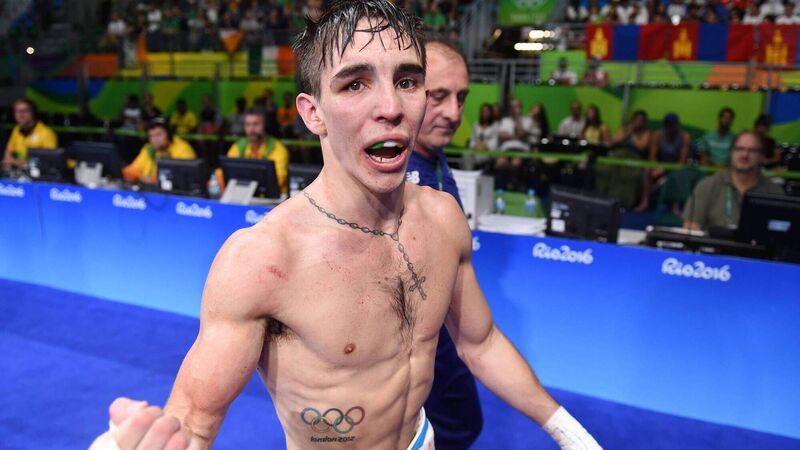Eimear Ryan: When medals are worth more than their weight in gold

Michael Conlan of Ireland following his Bantamweight Quarter final defeat to Vladimir Nikitin of Russia. Picture: Stephen McCarthy/Sportsfile
It's the business end of the championship for clubs, that crunch time when the spoils are divvied up for another year. On nights out, whether celebratory in nature or more about drowning sorrows, players are reflecting: On where it went wrong or right, on standout scores, on turning points. On the season gone by and the season to come.
We look at the older players in our midst and ask, with a bit of apprehension: You’ll give it another year, won’t you? Lately I’ve found myself on the receiving end of this question. To be fair, I’m into my third decade of playing adult club camogie now. There are a lot of miles on the clock.
And it’s starting to show. For most of my playing career, when it came to injury I was, in Cork parlance, haunted. I never had anything worse than a pulled muscle, never had to sit out training for longer than a couple of weeks. Most of the girls I played with had broken at least a finger at some point. On the pitch, I’d witnessed fractured wrists and hands, dislocated shoulders, torn ligaments and tendons. Aside from the usual litany of belts and bruises, nothing ever came for me.
Once I hit my 30s, it was a different story. This has been my third season in the last four years where I’ve missed games due to injury (2019 was my golden injury-free year). The role of the injured player is especially limited post-Covid. You used to be able to make yourself feel useful by carrying hurleys or water bottles; now, bellowing from the dugout is your only contribution.
If the end of a season is a time for reflection, then so is the twilight of your career. You take stock, physically and mentally. Is the spirit willing and the flesh weak? Is it the other way around? At this stage in a sporting life, you tend to get cold-eyed and analytical about your playing career as a whole. Can you keep playing at the standard you would like? Are there other hobbies and pursuits to which you would like to give your time? And is there a gap in the trophy cabinet, an elusive medal that you want to give yourself one more shot at?
They’re funny things, medals. I don’t have an abundance of them. But there are players, at both club and county, who have won two, three, five, six in a row. What must that feel like? Does the sixth medal feel as magical as the first? Does that winning feeling diminish over time, or keep getting better and better?
As a youngster, I loved medals — the ceremony of them, the shine, the ribbon. You’d win a few at your local Community Games and wear them around your neck as accessories, or hang them from a hook in your room.
As an adult, though, the symbolism is everything. It functions more like a talisman, a memory-conjurer: you hold it in your closed palm and remember the blood, sweat, and tears of the matches that earned it. The people you played alongside and the people who cheered you on. The nights to celebrate it.
And so my heart goes out to those athletes, like boxer Michael Conlan, who were cheated out of a medal and the ritual around it. In September, Conlan’s loss at the quarter-final stage at the 2016 Rio Olympics was found by an independent investigation to likely have been the result of ‘bout manipulation’ by officials. The inquiry placed as many as 11 fights at Rio under suspicion of being fixed.
It was vindication for Conlan, who called it at the time. In a post-fight interview with RTÉ, he criticised the AIBA (Amateur International Boxing Association), saying: “AIBA are cheats … I came here to win Olympic gold. My dream has been shattered now. Amateur boxing stinks from the core right to the top.”
Vowing never to box for the AIBA again, he turned pro soon afterwards. On publication of the investigation’s findings on September 30, he tweeted at the AIBA account: “Lads I want my medal, get it sorted an ill DM you my address. Thanks.”
Though there was bitter humour in Conlan’s tweet, he is absolutely right: He should be posted out his bronze medal. But what is the value, really, of a medal without the symbolism attached? Divorced from the experience of having it hung around your neck in the arena, or biting it like a cookie for the cameras when you arrive home? Worse, Conlan will never know if he could have driven on and won a silver or gold.
It’s the principle of the thing, though, and it’s certainly better late than never. It recently emerged that British swimmer Sharron Davies might be awarded a gold medal from the 1980 Moscow Olympics, over 40 years after coming second to Petra Schneider in the 400m individual medley. Schneider, who represented East Germany, subsequently admitted to being part of a state-sponsored doping regime that came to light after German reunification.
Rather generously, Davies suggested in an interview with the Telegraph that both she and Schneider were victims: “The whole of my career I knew that I was going into races with literally not a chance. It was incredibly obvious but, as individuals, we felt very sorry for the East Germans. It had terrible health consequences a long way down the line.”
In August, the New York Times ran a piece about the collectors’ market for Olympic medals, many of which have found their way into pawn shops and auction blocks over the years. A medal from the 1896 Olympics — the first modern Games — was recently auctioned off for six figures, while a bronze medal from the 1956 Winter Games fetched the tidy sum of $3,750.
As for the monetary value of the medals themselves, the gold medals won in Tokyo contain s6g of gold and about 550g of silver, and are worth about $800 (€685).
It’s unlikely that a senior county medal would fetch anything close to that on eBay. A medal like that, though, is worth so much more than its weight in gold.

Unlimited access. Half the price.
Try unlimited access from only €1.50 a week
Already a subscriber? Sign in











